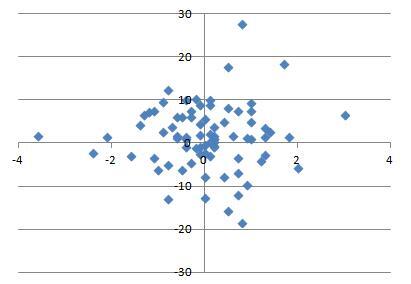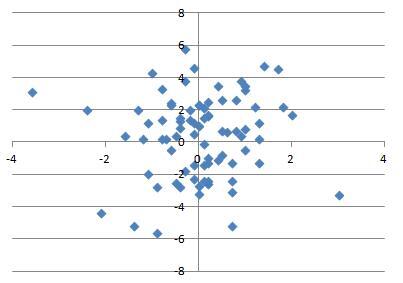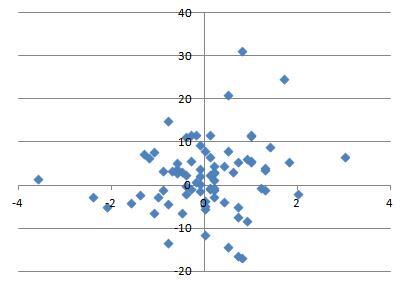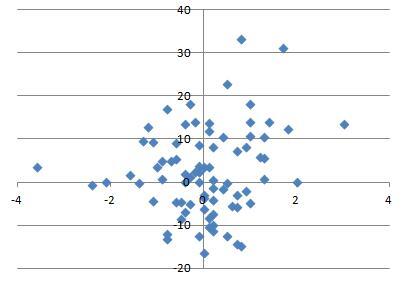Robinson Cano and the Value of Turning Two
Note: I have no idea if I’m the first to do this, but quite frankly I don’t care.
It’s no secret that Yankees second baseman Robinson Cano is an all-around excellent player, as he’s on his way to his fourth consecutive 5-win season. It’s also no secret that he’ll be a free agent after this season, and will certainly receive a contract in the nonuple figures. As the Angels have shown these past two offseasons, when you spend that much money on one player, you’d better be sure he’ll be worth it; the Yankees already have experience with terrible contracts (contracts they’re still due to pay for), so they’ll have very little room for error. Thus, executives of any and every team that might be interested in Cano will be doing their research, scouring the earth for any warning signs of a possible decline.
But back to Cano’s performance at the moment. While Cano is a superb player overall, much of his value comes from his bat; over this current 4-year 5-WAR streak, he’s been the seventh-best offensive player in the majors. The (relative) caveat in his game, therefore, is his defense: over that same span, he’s just 76th in fielding in the majors. Defensive statistics are subject to year-to-year fluctuations, and the fluctuations of Cano’s defense have been well documented. However, there’s a specific aspect of his defense that I’d like to focus on for the time being.
As you probably should know, UZR–the main defensive statistic at FanGraphs–is composed of four parts: RngR, which measures how many runs a player saves or costs his team with his range; ErrR, which measures how many runs a player saves or costs his team by committing or not committing errors; ARM, which measures how many runs a player saves or costs his team with his arm in the outfield; and DPR, which measures how many runs a player saves or costs his team by turning or not turning double plays. This last segment is the one that is so interesting, at least to me, because it’s the one that Cano is the worst in the league at.
No, really. Among 79 qualified infielders¹, Cano’s DPR of -3.6 is the worst, and the next worse player (Neil Walker) is a full 1.2 runs away, at -2.4 DPR².
Now, the real question becomes: what (if anything) does this mean? Obviously, when you’re preparing to give someone a contract that could exceed the GDP of whatever the fuck this country is, you’d prefer if he wasn’t the absolute worst in the majors at something, even a seemingly trivial thing like turning double plays. Still, though, it’s worth asking: what, exactly, is the significance of this?
There are a few different ways of looking at this; for the purpose of this post, I divided my analysis into 5 main categories:
1. Is this a fluke?
As I mentioned before, year-to-year defensive statistics can be quite fickle, so it’s best to gain some historical perspective when evaluating a player’s defense³. So, does Robinson Cano have a history of being a bad double play turner?
Well, on the one hand: In 2011, he was 6th out of 73 qualified infielders in DPR; in 2010, he was 13th out of 81; and in 2007, he was 2nd out of 89. These numbers would suggest that his horrific 2013 has been a fluke, except…
Last year, he was 61st out of 76; in 2009, he was 77th out of 81; in 2008, he was 67th out of 78; in 2006, he was 62nd out of 89; and in 2005, he was 75th out of 77.
Add it all up, and since he entered the league in 2005, Cano is 83rd out of 95 qualified infielders in DPR. However, it should be noted that before this year (i.e. from 2005 to 2012), Cano was 55th, a much more respectable figure, if not a particularly great one.
So, overall, it’s fairly safe to conclude that Cano has something of a poor history of turning double plays. What next?
2. Does a poor DPR correlate to poor defense in other areas?
To answer this question, I’ll bring up a few graphs. These’ll show us how well DPR this year has correlated to RngR…

…ErrR…

…UZR…

…and finally, whatever that Def stat is.

In case you were wondering, the R-squared values for these graphs were .000669, .004252, .028772, and .032933, respectively.
So there’s clearly no correlation between DPR and any other defensive statistic, which brings up the original question: What’s the point of all of this? Well…
3. Just how bad is a -3.6 DPR?
Quite bad, it turns out. In the illustrious 12-year history of the stat, the only worse seasons were Jas0n Bartlett in 2009 (-4.2)⁴, Yunel Escobar in 2008 (-3.7), and Omar Vizquel in 2005 (-4.0).
Again, this takes me back to my original point: when a player’s going to be paid a yearly salary that will exceed the total gross for this shitty movie, you generally don’t want him mentioned among the worst players in history (albeit a very short history).
Still, though, these three were/are good defensive–and all-around–players for the majority of their careers. So what’s to worry about?
4. How have players with similarly poor DPRs done in their seasons?
For this one, I’ll expand the criteria to all seasons with -3 DPR or worse; other than Cano this year, there are 11 such seasons:
| Player | Year | DPR |
| Neil Walker | 2011 | -3.2 |
| Jason Bartlett | 2010 | -3.1 |
| Yuniesky Betancourt | 2010 | -3.5 |
| Jason Bartlett | 2009 | -4.2 |
| Placido Polanco | 2008 | -3.1 |
| Yunel Escobar | 2008 | -3.7 |
| Brian Roberts | 2007 | -3.2 |
| Luis Castillo | 2006 | -3.0 |
| Omar Vizquel | 2005 | -4.0 |
| Jimmy Rollins | 2002 | -3.1 |
| Jose Vidro | 2002 | -3.5 |
Of these 11 seasons, the average WAR was 2.8, less than half of Cano’s WAR this year. The highest WAR was Bartlett’s 5.3 in 2009⁵, but overall the results were much lower.
So it would appear that Cano’s done something relatively new this season–play at a very high level while having a substandard DPR–but this still doesn’t answer the main question. I’ll answer that next, and the results are intriguing:
5. How have other players with DPRs this bad done for the rest of their careers?
Let’s continue to look at these 11 seasons. How were these players before and after their -3 DPR season?
| Player | WAR-Pre | WAR-Post | Off-Pre | Off-Post | Def-Pre | Def-Post |
| Neil Walker | 1.5 | 2.7 | 7.4 | 6.7 | -6.8 | -0.1 |
| Jason Bartlett | 3.5 | 0.8 | 4.4 | -16.7 | 10.5 | 5.4 |
| Yuniesky Betancourt | 0.4 | -1.4 | -15 | -23.8 | -1.4 | -7.7 |
| Jason Bartlett | 4.1 | 1 | 6.2 | -11 | 14.1 | 0.9 |
| Placido Polanco | 3.3 | 2.2 | 1.8 | -10.3 | 11.3 | 11.9 |
| Yunel Escobar | 3.6 | 3.1 | 10.2 | -0.5 | 6.4 | 10.9 |
| Brian Roberts | 3.1 | 2.4 | 5.4 | 3.9 | 5.5 | 0.1 |
| Luis Castillo | 2.5 | 1.7 | 1 | -0.8 | 4.6 | -1.8 |
| Omar Vizquel | 2.4 | 1 | -8.8 | -24.5 | 12.8 | 14.6 |
| Jimmy Rollins | 1.4 | 3.4 | -5.3 | 4.5 | 0.1 | 10.2 |
| Jose Vidro | 2.3 | 1.2 | 10.3 | 1.2 | -5.2 | -9.8 |
| Average | 2.6 | 1.7 | 1.6 | -6.5 | 4.7 | 3.2 |
(All values are per 600 PAs. Year of DPR is included in Pre.)
They all saw a noticeable drop off in their WAR; the only ones whose WAR increased were Rollins and Walker, and they had their bad seasons when they were young. Given that Cano will turn 31 in October, it’s safe to say this will not happen to him. Since Cano is getting older, a decrease in WAR to some degree should be expected, especially considering the volatility of his position; this has been covered before, though.
What I found interesting, though, was that the players’ defense (as measured by that fancy new Def stat) didn’t really drop off much after the bad DPR year, but their offense seemingly fell off a cliff. This goes against the theory of player aging curves (that offense can get better as players get older, but defense tends to just decline overall).
Obviously, this is a very small sample size, and to extrapolate anything meaningful from it would be foolish. Also, it’s pretty unlikely that the decline was caused by one bad year turning double plays.
This post as a whole was probably rather cockamamie⁶, but then again, everything I post here tends to be. I just hope I was able to raise some interesting questions about how much turning two matters to a player’s overall worth. Perhaps, years from now, when the Yankees are paying Cano $30 million a year to hit .250 with poor defense, and the Orioles have won the division year in and year out, I’ll be able to look back with pride at my prescience.
Or maybe, the Yankees will just win more World Series with or without Cano, while the Orioles dwell in mediocrity every year.
A man can dream, though….
——————————————————————————————————————
¹For some reason which escapes me, there isn’t an option to sort the leaderboards by solely infielders, even though there’s an outfielder option.
²Hopefully, you would’ve figured that out on your own, but I put it in there just to be safe. Also: All stats are as of Saturday, September 21st, 2013.
³Otherwise, you’ll end up with pieces-of-shit “analysis” like this.
⁴Bartlett also had a DPR of -3.8 in 2006, but he didn’t qualify that season.
⁵That was his ridiculous fluke season–you know, the one that Joe Maddon just gets out of every scrub the Rays find on the street.
⁶You have no idea how long I’ve waited to use that word.
Triple R enjoys pestering the writers at Camden Depot. He can be called R Cubed if you are so inclined. Referring to him by any other eponym may result in the infliction of great amounts of physical, mental, or emotional pain upon yourself, possibly inflicted by him, possibly inflicted by a third party. He is a terrible person. This is all you need to know about him.
Interesting, certainly interesting. Was a good read!
The double play stat is simply bs in my opinion as it does not consider the feed or range. If you watch every Yankee game like I do ( and this year it was brutal) you would know that Cano is simply the best at the turn and throw.
A better stay would be how many games orvruns Cano lost by not running out balls to first and second. It’s got to be embarrassing. Why he continues that style of play is baffling as Cano seems to care for his image and fellow human beings. A little hustle by a star impresses young players and fans a lot more than dogging it!
This seems relatively inconsequential as far as his overall value goes. Just based upon his own rankings in this metric, he has been one of the best, and one of the worst. There has to be so much noise in DP rates due to low sample sizes and needing chances, that it’s tough to forecast him at a -3.
Besides, you’re paying Cano to be a 2B who plays average defense, and provides a .380 wOBA. Even with being the worst (per this metric) at turning two in the league, he still rates out as an average 2B.
I wouldn’t pay him $30M/yr though. I don’t see any way fr the team to have any excess value there. 4/100 or maybe 5/125 are my limits if I’m NYY, and they would be somewhat less if I were a mid-market team.
While YOU wouldn’t give him an insane salary, you aren’t the GM of a team–and given that you’re reading FanGraphs right now, you’re probably more intelligent than a fair amount of GMs.
Pujols was initially offered 5/$130 from the Cardinals; Fielder was offered 6 and an undisclosed amount (stupid Boras) from the Nationals. They only signed for $200 when extenuating circumstances (Martinez’s knee, Moreno’s stupidity) occurred. In this case, the Dodgers’ dearth of second basemen might do the trick–especially if they fall short of a title. If we’ve learned anything from these last few years, it’s that (a) when you’re beating on free-agent contracts, take the over, and (b) GMS NEVER LEARN (especially if they’re in LA).
As for your and Spencer’s comments on DPR itself, I’m less knowledgable on the actual calculation than you are. I just know to trust the guys that make the stats, cuz they tend to be correct. Plus, if he does go to the Dodgers, his DP partner will be HanRam, who isn’t much of a defensive upgrade over Jetes.
Right on schedule…
http://espn.go.com/new-york/mlb/story/_/id/9725806/robinson-cano-seeking-10-year-305-million-deal
Not sure how the stat is calculated so I could be off base here but given the fact that Cano has had largely the same DP partner for his career does that have any impact on it?
If that is true then it could be possible that he isn’t as bad as his numbers says he is, not sure, just throwing it out there.
If you’re a scout, stats, even if they’re open to some interpretation, give you an indication of what is going on in the field. They add to what you know of the game and what you see day to day. Cano’s footwork around second base is the quickest and his arm one of the strongest in baseball. He is a sure handed 2nd baseman and his range is second to none. So why hasnt he turn more DPs this year? He cannot make DPs on his own, he’s a pivot man. Somebody has to get him the ball. The Yankees this year have seen a parade of fringe major leaguers at third and short. In many games I have seen a ball hit to the left side and I say DP to myself. At the end, I see Cano coming across 2nd base, ball in glove , no throw. Watching almost every game and every inning this year, it is amazing how much this has happened. The whole infield has underperformed. This is not surprising since the Yankees did not have Arod,Jete and Tex all year. So to say that Cano’s fielding is hurting the Yankees or his fielding is average at best, it is against everything that your eyes see day to day.
I wonder if his DP rate has gone up since Brendan Ryan started at short. I know, I know, small sample size but my eyes say yes.
Again, you’re probably right as a whole. If we assume 10 runs is a win, then a DPR of -3 as opposed to, say, +3, is a difference of .6 wins. That’s fairly insignificant.
As I said in the article, the general thinking behind this is that when you’re paying a guy a shitton of money, you’d like him to be great–or at least good–at, well, everything; you certainly wouldn’t want him to be the absolute worst at something.
Also, it’s not like Cano doesn’t have a history of a poor DPR, and many of the poor years I cited were from when Jeter was healthy the whole year. And again, if he indeed goes across the country to Magic Johnson’s Dream Team, he’ll likely be paired with Hanley Ramirez, who is a poor defender in his own right.
How is the DP stat derived?
good read, but lose the self indulgent “bio” bro. a bit much to describe yourself that way
I shan’t change my bio; reading the penultimate sentence should tell you why.
I don’t need to see any stats…I watch the games and when it comes to being the guy that actually makes the “turn”…Cano is the best in the league. No question.
His release is so fast and his arm is so strong that he doesn’t need to get into a position that gives him leverage. His footwork is great even though it looks nonchalant(sound familiar?). He turns that double play better than anyone.
If anything this stat is just indicative of how flawed all of these stats are. This is the area in the field in which Cano excels the most.